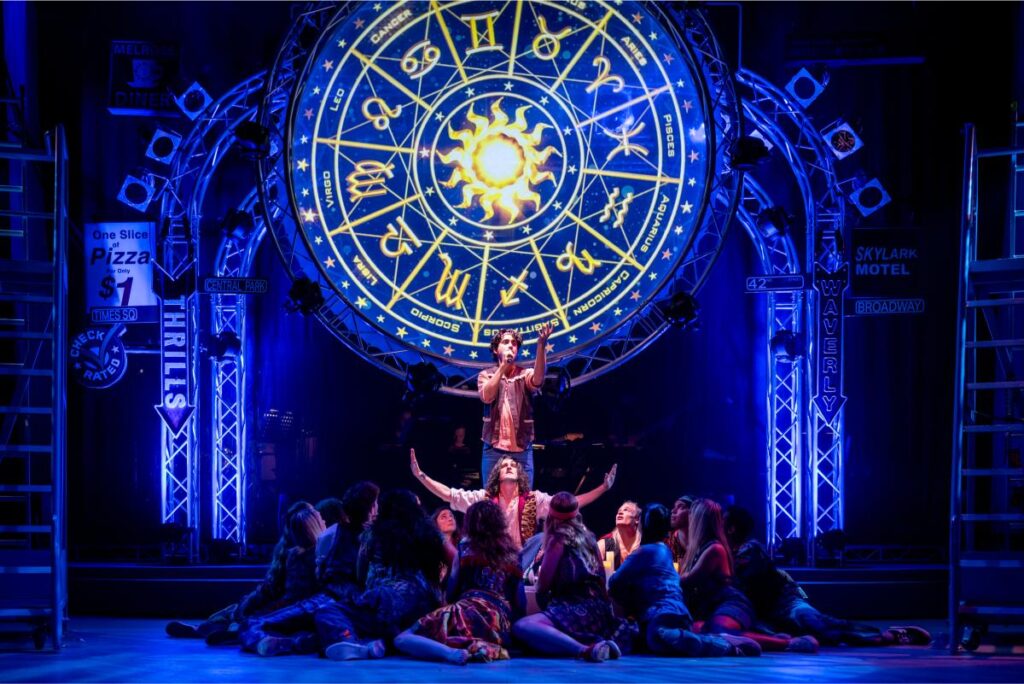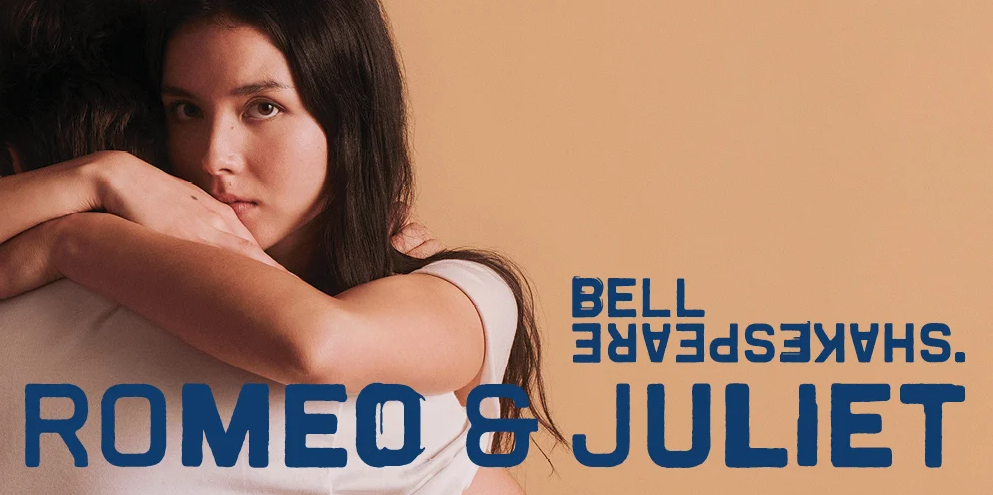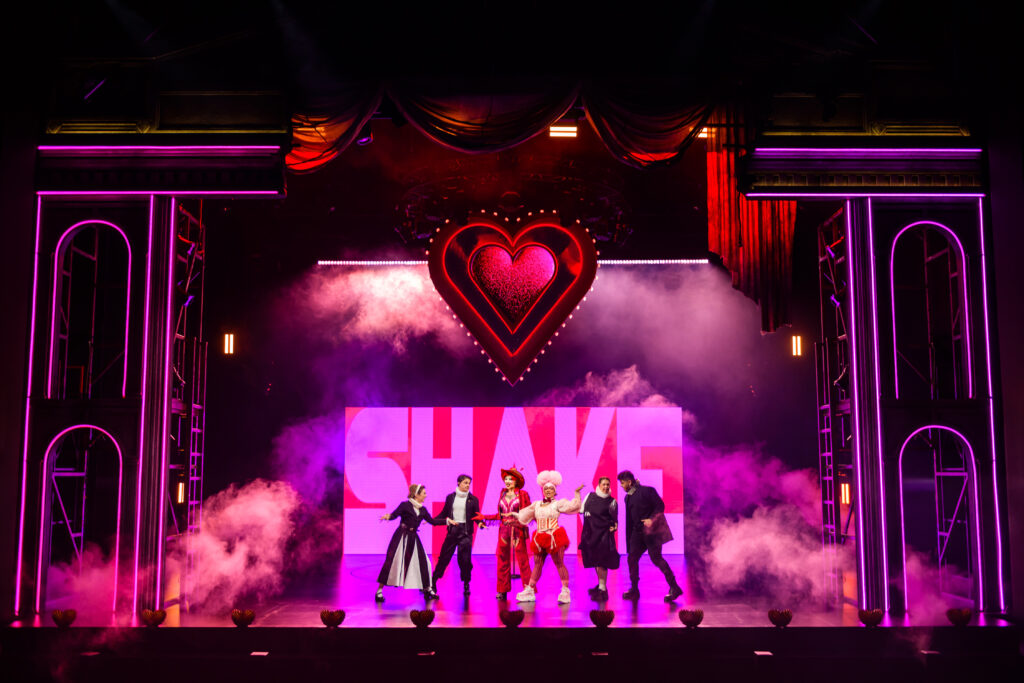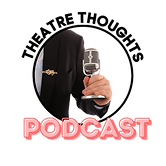
Reviewed By
Type – Energetic, Political, Psychedelic
If you liked – RENT, Godspell, Political Theatre
Hair: The Tribal Love-Rock Musical returns as a poignant reminder of the swiftness of life
Much of Hair has not the vibe of a musical but the vibe of a concert. Whilst the songs have an interconnected themes and do tell a narrative, they exist as standalone standards of rock and roll. The musical was first premiered in 1967 at the Off Broadway JosephPapp’s Public Theatre at a time when musicals often took us to far off lands and fantasy realms. Hair kept it simple and real and home. It was a musical for the youth, set right when it premiered, in 1967 New York. Hair has been written about as more than just a musical, it is a ‘happening’, a term coined during this time to describe events that were much more than they were.
A large projection screen flanked with a steel stage thrust sits over the concert decked stage below. The band are positioned right at the back, only partly visible from the audience. On either side of the stage are two movable stairwells with buckets of props used throughout. Centre stage sits the set, designed by Kaspa, a bed decorated with a black and white yin and yang symbol and surrounding are the street signs of New York.
Hair & The Vietnam War
Contextually, Hair registers as a rebellion. When millions of youths were conscripted into the US Army to fight in the Vietnam War during The Draft, names became birth dates, then letters delivered at random. 26,800,000 men were eligible, of which 1.9 million were sent to fight in the War. A similar process took place in Australia. The war was the first truly televised war, terrifying men of the prospect of their birth date appearing. Those drafted were sent to an induction centre for military discipline and training. Then they were sent to kill.
The Vietnam War saw the largest anti-war protests in history, with almost half drafted never setting foot on a plane nor on Vietnamese soil. People dodged and resisted The Draft regardless of the harsh criminal penalties. Something universal happened, a movement of protest and peace occured. People began dropping out of the status quo and adopted peace-led ideals. They listened to psychedelic sounds, sang their own folk music, and often lived in communes. These people became known to the world as “Hippies”.

The Melbourne Revival
Hair has an enormous cast. The first quarter of the musical is spent introducing characters and their performers with songs. Because Hair shares the tradition of late 60s music, vocally the cast are required to take on this quality. With an unusually long list of numbers, and minimal scripted dialogue, the acting is less emphasised. The scripted dialogue consisted of jokes, interludes and gaffes with a narrative of peace, sex, love, uncertainty, hope, protest and war. Director Glenn Elston, the Artistic Director of the Australian Shakespeare Company, utilises effective blocking and line delivery. Whilst each performer had a unique voice and character, none truly stood out as the star of the show, instead favouring a more communal company.
The storyline of Hair is almost transient, told barely through its songs and littered through the banter in between, and it can easily be lost by the audience. Hair is not known for its script so much as it is for its message. Societal dropouts become part of a large hippie commune in New York led by George Berger. The commune is a mix of university students, fulltime activists and those trapped in a drug-induced purple haze. Claude Bukowski is a young hippie caught up in The Draft, he joins the commune claiming to be a mod from from Manchester England.
After a long period of protesting the Vietnam War and practicing free-love on an enormous communal bed, George and Claude receive their draft cards and are summoned to the Induction Centre, given very basic military discipline training before being placed on cold, green warplanes and flown to Vietnam.
The second act of Hair has an eerie sense of unease creeping over it. The pace is slower despite fewer songs. The set design becomes more complex. Hair is – at its heart – a political performance. A particularly poignant moment sees an enormous USA flag drape the diameter of the stage, on it is projected real footage depicting the horrors of the Vietnam War.
Creative Choices in Hair
Costume design, by Karla Erenbots is simple, psychedelic and earthy as she utilises skirts, jeans and tops toasted with a peace sign necklace. This is true to what hippies would have worn back in the late 60s which focused on easy, environmentally friendly fashion. The lack of colour from Kaspa’s set design allowed the vibrancy in Erenbots costumes to pop on stage.
Hair has some utterly fantastic songs. Its opening ‘Aquarius’, namesake ‘Hair’ and ‘Let the Sunshine In’ all became pop hits in their own right, not many musicals can attest to having their songs become part of the generation they were trying to capture. Musical director Colin Snape gave the songs a very rich, rock energy in comparison to the original stage recordings which hold a far more mellow quality.
Is Hair Worth Seeing in Melbourne?
Hair will appeal not just to lovers of musical theatre, but also a wider audience interested in classic rock and social justice. Hair is a phenomenon for a reason. When it premiered, showings were shut down by authorities. The Melbourne premiere finished without any police officers but instead with a sombre reminder of the swiftness of life.
Despite The Draft being a distant memory, Hair is as important as ever.

Tickets and Practical Info for HAIR in Melbourne 🎟️
Tickets: https://www.ticketmaster.com.au/hair-tickets/artist/2844537
Until 30th November
Australian Shakespeare Company
Athenaeum Theatre, Melbourne CBD, Victoria
Cast Alex Cooper, Maxwell Simon, Elizabeth Brennan, Clay Darius, Max Mcdonald, RoaeMeader, Jackson McGovern, Maverick Newman, Giorgia Kennedy, Grant Young, Linden Trescott, Larissa Teale, Bronte Horswood, Tamara Foglia Castaneda, Teresa Moore, Zarah Andrews, Madeline Somers, Cameron Shook.
Directed by Glenn Elston OAM
Greg Hocking OAM: Co-Producer
Kaspa: Production Design
Carla Erenbots: Costume Design
Lindsay Field: Vocal Arrangements
Harrison Cope: Lighting Designer
Will Burston: Sound Designer
Sue-Ellen Shock: Choreographer
Paul Norton: Music Coordinator
Musicians: Colin Snape, Alessandro Martello, Daniel Tusjack, James Davies, Troy Downward





